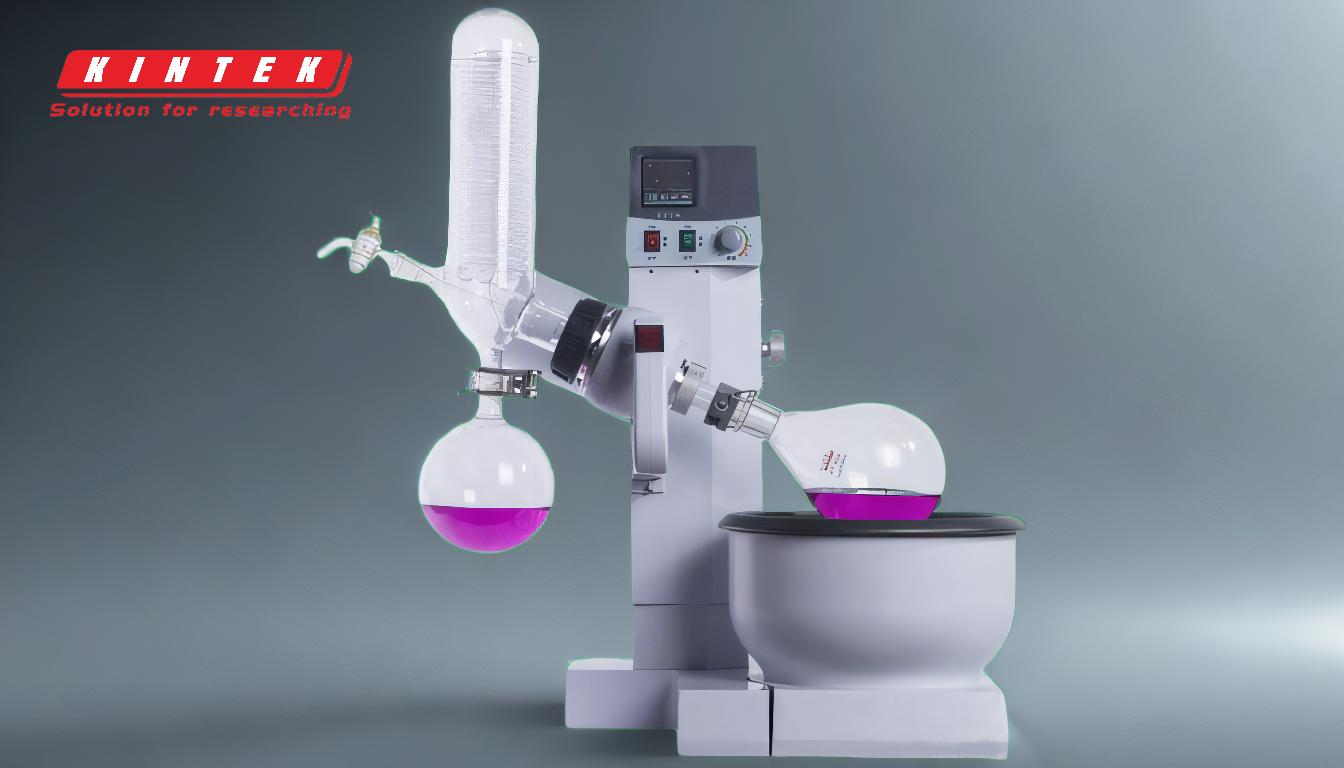A rotary evaporator, commonly referred to as a rotavap, is a sophisticated laboratory instrument designed for efficient solvent removal through vacuum distillation. Its primary features include a rotating flask, vacuum pump, heating bath, condenser, and receiving flask, all working in unison to facilitate rapid and controlled evaporation. The rotating flask enhances the evaporation surface area, while the vacuum pump reduces pressure, lowering the boiling point of the solvent. The heating bath provides controlled heat, and the condenser cools and recondenses the vapor into liquid form, which is collected in the receiving flask. Additional features like a bump guard, temperature and speed control knobs, and a vacuum release valve ensure safe and precise operation. These features make rotary evaporators ideal for applications in laboratories, pilot tests, and material extraction, offering high efficiency, compact design, and contamination-free operation.
Key Points Explained:

-
Vacuum Distillation System:
- The rotary evaporator operates under reduced pressure, achieved by a vacuum pump. This lowers the boiling point of the solvent, enabling evaporation at lower temperatures, which is crucial for heat-sensitive materials.
- The vacuum system includes a vacuum release valve, allowing for controlled pressure adjustments and safe operation.
-
Rotating Flask:
- The flask rotates at 150-200 rpm, creating a thin film of the sample on the inner surface. This increases the evaporation surface area, enhancing the efficiency of solvent removal.
- The rotation also minimizes the risk of bumping, where sudden boiling can cause the sample to splash into the condenser.
-
Heating Bath:
- The water bath provides uniform and controlled heating, typically maintained at 30-40°C. This ensures gentle and consistent evaporation of the solvent.
- Temperature control knobs allow precise adjustments, catering to the specific requirements of different solvents.
-
Condenser and Cold Finger:
- The condenser, often equipped with a cold finger, cools the solvent vapors, converting them back into liquid form. The cold finger must be kept at -10°C to 0°C, often using dry ice or a coolant mixture.
- This component is critical for solvent recovery, enabling reuse and reducing waste.
-
Receiving Flask:
- The recondensed solvent is collected in a receiving flask, which is easily detachable for convenient disposal or further analysis.
- This feature ensures a closed-loop system, enhancing safety and efficiency.
-
Bump Guard:
- A bump guard is integrated to prevent the sample from splashing into the condenser during sudden boiling or pressure changes. This protects the integrity of the distillation process and reduces contamination risks.
-
Compact and Contamination-Free Design:
- The rotary evaporator is designed to be compact and user-friendly, with an intuitive interface for easy operation.
- Its construction minimizes metal ion contamination, making it suitable for applications requiring high purity, such as pharmaceutical and chemical research.
-
Versatility and Applications:
- Rotary evaporators are versatile tools used in laboratories, pilot tests, and industrial processes. They are particularly valuable for extracting precious materials and conducting solvent recovery.
- Their sealing performance is comparable to high-end foreign machines, ensuring reliable and consistent results.
By combining these features, rotary evaporators offer a highly efficient, safe, and versatile solution for solvent evaporation and recovery, making them indispensable in modern scientific and industrial settings.
Summary Table:
| Feature | Description |
|---|---|
| Vacuum Distillation | Operates under reduced pressure, lowering boiling points for heat-sensitive materials. |
| Rotating Flask | Enhances evaporation surface area and prevents bumping during operation. |
| Heating Bath | Provides uniform heat (30-40°C) for controlled solvent evaporation. |
| Condenser & Cold Finger | Cools vapors for solvent recovery, often using dry ice or coolant. |
| Receiving Flask | Collects recondensed solvent for disposal or analysis. |
| Bump Guard | Prevents sample splashing, ensuring safe and contamination-free operation. |
| Compact Design | User-friendly, contamination-free, and ideal for high-purity applications. |
| Applications | Used in labs, pilot tests, and industrial processes for solvent recovery and material extraction. |
Looking for a reliable rotary evaporator? Contact us today to find the perfect solution for your lab!












